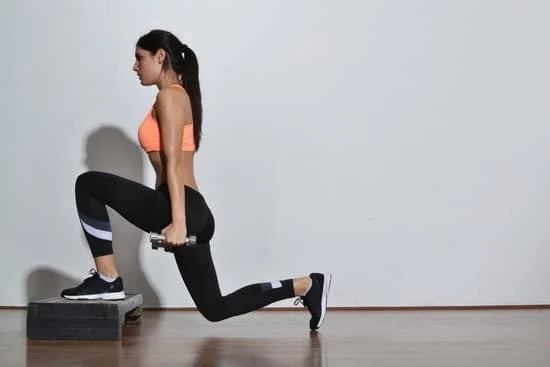Fitness walking is considered what type of exercise? This question often arises when individuals are exploring different forms of physical activity to incorporate into their daily routine. Fitness walking, also known as power walking or brisk walking, is a moderate-intensity aerobic exercise that offers a wide range of health benefits. From improving cardiovascular fitness to boosting mental well-being, fitness walking is a versatile and accessible form of exercise for people of all ages and fitness levels.
Walking is a fundamental human movement that has been shown to have numerous positive effects on physical health. Not only does it help strengthen muscles, improve flexibility, and increase bone density, but it also plays a significant role in reducing the risk of chronic diseases such as heart disease, diabetes, and obesity. Furthermore, the low impact nature of fitness walking makes it a suitable option for individuals recovering from injuries or those looking to maintain joint health.
Aside from the physical benefits, fitness walking also has a profound impact on mental health. Studies have shown that regular participation in brisk walking can reduce symptoms of anxiety and depression while enhancing overall mood and cognitive function. The rhythmic motion of walking coupled with time spent outdoors in nature can have a calming effect on the mind, making it an excellent stress-reliever for those leading busy and hectic lifestyles.
Benefits of Fitness Walking for Physical Health
Fitness walking is considered a type of aerobic exercise that offers numerous benefits for physical health. One of the key advantages of fitness walking is its ability to improve cardiovascular fitness. When you engage in regular brisk walking, your heart rate increases, which helps strengthen your heart and lungs. This can lead to improved overall cardiovascular health, reducing the risk of heart disease and stroke.
Moreover, fitness walking is a weight-bearing exercise, which means it can help improve bone density and reduce the risk of osteoporosis. As you walk, the impact on your bones helps stimulate the growth of new bone tissue, making them stronger and less susceptible to fractures. This makes fitness walking an excellent option for individuals looking to maintain healthy bones as they age.
| Physical Health Benefits | Details |
|---|---|
| Improved Cardiovascular Fitness | Strengthens heart and lungs, reduces risk of heart disease. |
| Enhanced Bone Density | Weight-bearing nature stimulates bone growth, reduces osteoporosis risk. |
| Better Joint Health | Low-impact exercise that minimizes stress on joints compared to high-impact activities like running. |
Benefits of Fitness Walking for Mental Health
Fitness walking is considered what type of exercise that not only benefits physical health but also has a significant positive impact on mental well-being. Engaging in regular fitness walking can contribute to improved overall mood, reduced stress levels, and enhanced cognitive function. The combination of physical activity and time spent outdoors during a walk can have a powerful effect on mental health.
One of the key benefits of fitness walking for mental health is its ability to reduce symptoms of anxiety and depression. Studies have shown that participating in a consistent walking routine can help alleviate feelings of sadness, anxiety, and even improve self-esteem. This form of exercise releases endorphins, which are known as the “feel-good” hormones, contributing to an overall sense of well-being.
In addition to reducing negative emotions, fitness walking has been linked to better sleep patterns and increased energy levels throughout the day. Regular physical activity like walking has shown to improve the quality of sleep, making it easier to fall asleep and stay asleep. The combination of improved physical health and mental well-being makes fitness walking a valuable form of exercise for individuals looking to boost their overall wellness.
| Benefit | Impact |
|---|---|
| Reduced anxiety and depression symptoms | Improved mood and self-esteem |
| Better sleep patterns | Increased energy levels |
Comparison of Fitness Walking With Other Types of Exercise
When it comes to choosing the right type of exercise for your fitness goals, it’s important to consider the benefits of each option. Fitness walking, also known as power walking or brisk walking, is considered a moderate-intensity aerobic activity that can provide numerous advantages for overall health and well-being.
One key aspect to consider when comparing fitness walking with other types of exercise is its accessibility. Unlike some forms of physical activity that require expensive equipment or memberships, all you need for fitness walking is a good pair of supportive shoes and a safe place to walk. This makes it an affordable and convenient option for individuals of all ages and fitness levels.
Additionally, fitness walking is a low-impact exercise that puts less stress on joints compared to high-impact activities like running or jumping. This makes it an ideal choice for those with joint pain or arthritis, as it allows them to improve cardiovascular endurance and muscle strength without risking injury. Overall, the versatility and adaptability of fitness walking make it a great choice for anyone looking to improve their health and well-being through regular physical activity.
Importance of Proper Form and Technique in Fitness Walking
Proper form and technique are essential components of fitness walking, as they can significantly impact the effectiveness and benefits of this type of exercise. Whether you are a beginner or an experienced walker, focusing on your form can help prevent injuries and maximize the results of your workout. Here are some key points to keep in mind when it comes to the importance of proper form and technique in fitness walking:
- Posture: Maintaining good posture is crucial while fitness walking. Keep your head up, shoulders back, and engage your core muscles. This alignment helps distribute the weight evenly and reduces strain on your joints.
- Arm Swing: Your arms should move in sync with your legs while fitness walking. Bend your elbows at a 90-degree angle and swing them naturally back and forth. This motion not only increases your speed but also engages your upper body muscles.
- Foot Placement: Pay attention to how your feet land with each step. Your heel should strike the ground first, followed by rolling through to push off with the toes. Avoid overstriding, as it can lead to injuries and decrease efficiency.
Maintaining proper form not only enhances the physical benefits of fitness walking but also promotes overall well-being. By incorporating these techniques into your routine, you can make the most out of this low-impact yet effective form of exercise.
- Deep Breathing: Focus on taking deep breaths in sync with your steps while fitness walking. Proper breathing technique improves oxygen flow to your muscles, increases endurance, and reduces fatigue.
- Pace Control: Find a comfortable pace that allows you to walk briskly without causing undue strain or exhaustion. Gradually increasing your speed and distance over time can help challenge yourself while avoiding burnout.
- Cool Down Stretches: After completing your fitness walking session, take time to cool down with some stretching exercises. Focus on hamstrings, calves, quads, and hip flexors to maintain flexibility and prevent muscle tightness.
Overall, mastering proper form and technique in fitness walking is key to reaping its numerous benefits for both physical health and mental well-being. By paying attention to these details during your workouts, you can elevate your performance, reduce injury risk, and enhance the overall experience of engaging in this enjoyable form of exercise.
How to Get Started With a Fitness Walking Routine
Fitness walking is considered a type of aerobic exercise that can offer numerous benefits for both physical and mental health. If you’re looking to start a fitness walking routine, here are some tips to help you get started:
1. Set realistic goals: Determine how often you want to walk each week and for how long. Start with manageable time frames and gradually increase the duration as your fitness level improves.
2. Invest in proper footwear: To prevent injury and ensure comfort during your walks, it’s important to invest in a good pair of walking shoes that provide support and cushioning.
3. Find a suitable route: Choose a safe and scenic route for your walks, whether it’s around your neighborhood, through a local park, or on designated walking trails. Varying your route can help keep things interesting and prevent boredom.
4. Warm up and cool down: Before starting your walk, spend a few minutes warming up with dynamic stretches or light exercises to prepare your muscles. After finishing your walk, don’t forget to cool down with some static stretching to help prevent muscle soreness.
5. Track your progress: Keep track of your walking distance, speed, and any noticeable improvements in fitness over time. This can help motivate you to continue with your routine and set new goals for yourself.
By following these tips and starting a fitness walking routine, you can experience the many benefits this type of exercise has to offer while improving your overall health and well-being.
Tips for Increasing Intensity and Effectiveness in Fitness Walking
When it comes to increasing the intensity and effectiveness of fitness walking, there are a few key strategies to keep in mind. By incorporating these tips into your routine, you can maximize the benefits of this popular form of exercise.
Interval Training
One effective way to boost the intensity of your fitness walking routine is to incorporate interval training. This involves alternating between periods of higher intensity, such as brisk walking or power walking, with periods of lower intensity or rest. By challenging yourself with bursts of increased speed or incline, you can elevate your heart rate and burn more calories during your walk.
Incorporate Strength Training
While fitness walking primarily targets the lower body muscles, you can increase the overall effectiveness of your workout by incorporating strength training exercises. Consider adding bodyweight exercises like lunges, squats, or calf raises during your walk to engage additional muscle groups and enhance the toning effects of your routine.
Increase Distance and Frequency
Another way to ramp up the intensity of fitness walking is to gradually increase the distance and frequency of your walks. By challenging yourself to walk longer distances or more frequently throughout the week, you can continue to improve your cardiovascular endurance, build stamina, and see greater improvements in overall fitness levels.
By implementing these tips for increasing intensity and effectiveness in fitness walking, you can take your routine to the next level and reap even more benefits from this versatile form of exercise. Remember to listen to your body, stay hydrated, and consult with a fitness professional if you have any concerns about pushing yourself too hard. Fitness walking is considered a moderate-intensity exercise that offers numerous health benefits when done correctly and consistently.
Common Mistakes to Avoid When Engaging in Fitness Walking
When it comes to fitness walking, many individuals may not realize that certain mistakes can hinder their progress and potentially lead to injury. Avoiding these common pitfalls is essential for maximizing the benefits of this exercise and preventing setbacks in your fitness journey.
Skipping Proper Warm-Up and Cool Down
One of the most crucial aspects of any exercise routine, including fitness walking, is ensuring you properly warm up your muscles before starting and cool them down afterwards. Failing to do so can increase your risk of strains, sprains, and other injuries. A proper warm-up can consist of dynamic stretches or a short walk at a slower pace before picking up speed. Similarly, a cool-down should involve stretching exercises to help relax your muscles post-workout.
Overdoing It Too Soon
Another mistake to avoid when engaging in fitness walking is overexerting yourself too soon. While it’s important to challenge yourself to see improvements in your fitness level, pushing too hard can lead to burnout or injury. It’s essential to gradually increase the intensity and duration of your walks over time to allow your body to adjust and prevent overtraining.
Improper Footwear and Technique
Wearing the wrong shoes or using improper walking technique can also negatively impact your fitness walking routine. Investing in a pair of supportive, comfortable shoes specifically designed for walking can help prevent discomfort and foot issues. Additionally, focusing on maintaining proper posture, swinging your arms naturally, and landing on your heel-to-toe with each step can improve efficiency and reduce the risk of injury during your walks.
By being mindful of these common mistakes and taking steps to avoid them, you can make the most out of your fitness walking routine while reaping its numerous benefits for both physical and mental health.
Expert Advice on the Best Gear and Equipment for Fitness Walking
When it comes to fitness walking, having the right gear and equipment can make all the difference in your workout routine. From proper footwear to comfortable clothing, choosing the best gear for fitness walking can enhance your experience and maximize the benefits of this type of exercise.
One of the most important pieces of gear for fitness walking is a good pair of walking shoes. Look for shoes that provide ample support, cushioning, and stability to prevent injuries and discomfort during your walks. It is recommended to visit a specialty store where experts can analyze your gait and help you find the perfect shoe for your feet.
In addition to proper footwear, wearing moisture-wicking clothing that allows for breathability and movement is essential for a successful fitness walking session. Choose fabrics that will keep you dry and comfortable throughout your walk, especially if you plan on walking long distances or in varying weather conditions.
Additionally, consider investing in a supportive sports bra and comfortable socks to complete your fitness walking outfit. Remember, the right gear can make all the difference in achieving your fitness goals through this enjoyable form of exercise.
How Fitness Walking Can Help Achieve Weight Loss and Overall Fitness Goals
Fitness walking is considered a type of aerobic exercise, specifically a form of moderate-intensity physical activity. It is an accessible and effective way to improve both physical and mental well-being. With its numerous benefits, fitness walking is a popular choice for individuals seeking to achieve weight loss and overall fitness goals.
One of the key advantages of fitness walking for weight loss is its ability to burn calories while being gentle on the joints. By engaging in regular brisk walking sessions, individuals can increase their heart rate, strengthen muscles, and boost metabolism. Additionally, incorporating hills or intervals into the routine can further enhance calorie expenditure and promote fat loss.
In conclusion, fitness walking offers a holistic approach to achieving weight loss and overall fitness goals. By combining the physical benefits of aerobic exercise with the mental benefits of spending time outdoors, individuals can make significant strides towards improving their health and well-being. Whether starting out as a beginner or looking to elevate their fitness routine, anyone can benefit from incorporating fitness walking into their daily regimen.
Frequently Asked Questions
What Kind of Exercise Is Walking Considered?
Walking is considered a form of aerobic exercise, as it gets your heart rate up and increases your breathing rate. It is a low-impact activity that can be done by people of all fitness levels.
Is Walking Aerobic or Muscular?
Walking primarily falls under the category of aerobic exercise, but it also has muscular benefits. While it does not build muscle mass like weightlifting, walking can help strengthen and tone muscles in the lower body, including the calves, quadriceps, and glutes.
What Is Fitness Walking Class?
Fitness walking classes are group sessions led by instructors that focus on proper walking techniques and movements to maximize the benefits of walking as an exercise. These classes often incorporate elements of cardio and strength training to provide a comprehensive workout for participants.
They can be suitable for individuals looking to improve their cardiovascular health and overall fitness levels through walking-based workouts.

Passionate about providing useful information to anyone with an interest in the field of Personal Training, I strive to pass on to our readers quality information and to answer any questions about Personal Trainers, the work they do and how to become one.





